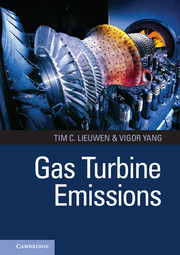Book contents
- Frontmatter
- Contents
- List of Contributors
- Foreword
- Preface
- Part 1 Overview and Key Issues
- Part 2 Fundamentals and Modeling: Production and Control
- Part 3 Case Studies and Specific Technologies: Pollutant Trends and Key Drivers
- 9 Partially Premixed and Premixed Aero Engine Combustors
- 10 Industrial Combustors
- Index
- References
9 - Partially Premixed and Premixed Aero Engine Combustors
from Part 3 - Case Studies and Specific Technologies: Pollutant Trends and Key Drivers
Published online by Cambridge University Press: 05 June 2013
- Frontmatter
- Contents
- List of Contributors
- Foreword
- Preface
- Part 1 Overview and Key Issues
- Part 2 Fundamentals and Modeling: Production and Control
- Part 3 Case Studies and Specific Technologies: Pollutant Trends and Key Drivers
- 9 Partially Premixed and Premixed Aero Engine Combustors
- 10 Industrial Combustors
- Index
- References
Summary
Introduction
Premixed combustors for aero engines have been under development for nearly forty years, yet, at the time of writing, the first airplane with premixed combustion still awaits its entry into service. On the other hand, industrial gas turbines have made the transition to premixed combustion within ten years and the level of emissions of nitrogen oxides has decreased tenfold. The differences are due to the peculiarities of gas turbines in flight and a large part of the chapter will be devoted to the understanding of the consequences of those differences for premixed or partially premixed combustion. An obvious difference between both applications lies in the fuels, which are predominantly gaseous for industrial gas turbines and exclusively liquid for aero engines and will continue to be for the foreseeable future. Therefore, premixing in aero combustors always needs to be discussed together with prevaporization, and the differences imposed on the liquid fuel preparation by full or partial prevaporization and premixing are responsible for a large part of the overall development effort. The other determining differences result from the thermodynamic cycles specific to high bypass ratio engines and the impact of the flight profile on the implementation of part load operation. The latter has already been described in Chapter 1.5 and the concept of staging in lean aero engines has been presented in Section 1.5.3 such that this chapter will concentrate more on the implementation of staging and its consequences on the design of the combustor components.
The chapter consists of three parts that partly also follow a historical order: Some results of research are presented that are relevant for lean premixed, prevaporized (LPP) combustion, which for a large part were concurrently achieved with development efforts on LPP combustors. Understanding the limitations and difficulties in the way of fully prevaporized premixed combustion, the concept with the highest emissions reduction potential, will then supply the base for the discussion of partially premixing combustors and their operability aspects.
- Type
- Chapter
- Information
- Gas Turbine Emissions , pp. 237 - 289Publisher: Cambridge University PressPrint publication year: 2013
References
- 2
- Cited by



